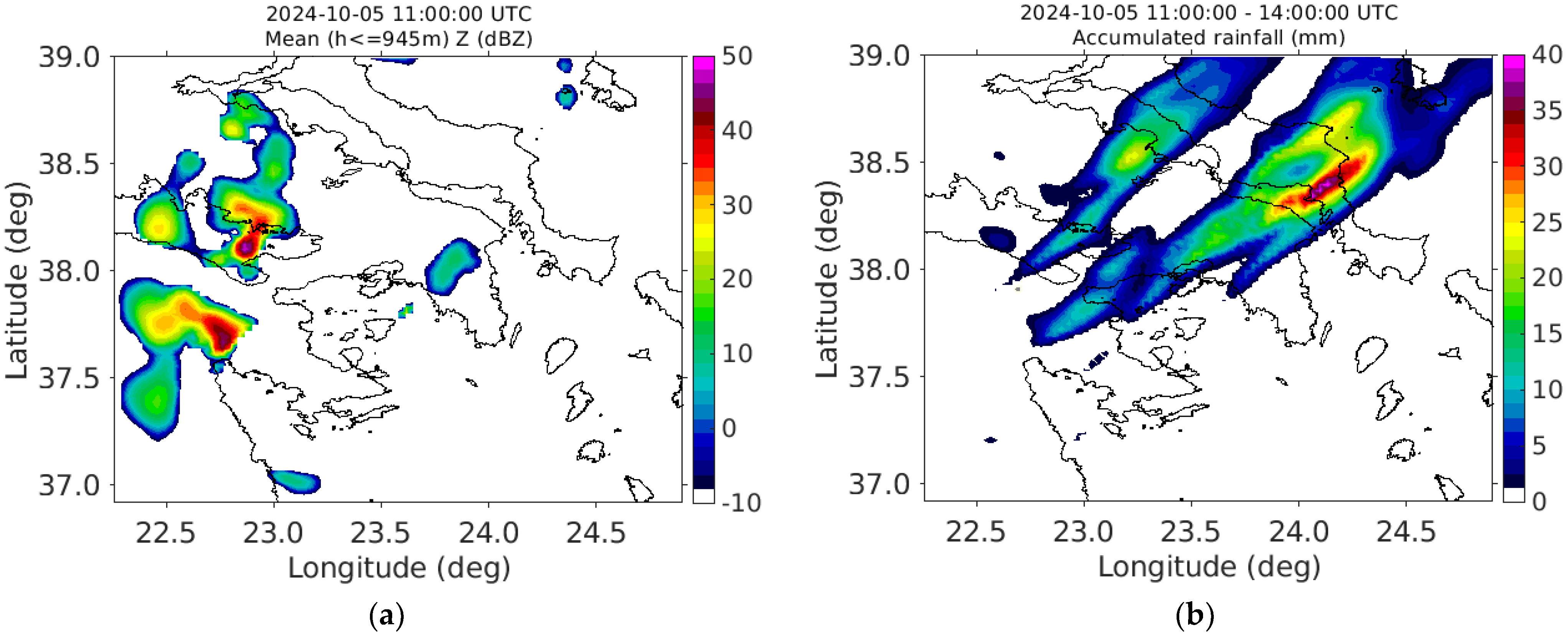Precipitation Nowcasting with Weather Radar and Lightning Data Assimilation †
Abstract
1. Introduction
2. Data and Methodology
3. Results
4. Discussion and Conclusions
Author Contributions
Funding
Data Availability Statement
Acknowledgments
Conflicts of Interest
References
- Wang, H.; Sun, J.; Zhang, X.; Huang, X.; Auligne, T. Radar data assimilation with WRF 4D-Var. Part I: System development and preliminary testing. Mon. Weather Rev. 2013, 141, 2224–2244. [Google Scholar] [CrossRef]
- Mazzarella, V.; Ferretti, R.; Picciotti, E.; Marzano, F.S. Investigating 3D and 4D variational rapid-update-cycling assimilation of weather radar reflectivity for a heavy rain event in central Italy. Nat. Hazards Earth Syst. Sci. 2021, 21, 2849–2865. [Google Scholar] [CrossRef]
- Liu, Z.Q.; Ban, J.M.; Hong, J.S.; Kuo, Y.H. Multi-resolution incremental 4D-Var for WRF: Implementation and application at convective scale. Quart. J. R. Meteor. Soc. 2020, 146, 3661–3674. [Google Scholar] [CrossRef]
- Yang, S.; Li, D.; Huang, X.Y.; Liu, Z.; Pan, X.; Duan, Y. Assimilation of Radar Reflectivity via a Full-Hydrometeor Assimilation Scheme Based on the WSM6 Microphysics Scheme in WRF 4D-Var. Mon. Weather. Rev. 2024, 152, 1303–1320. [Google Scholar] [CrossRef]
- Chen, Z.; Sun, J.; Qie, X.; Zhang, Y.; Ying, Z.; Xiao, X.; Cao, D. A method to update model kinematic states by assimilating satellite-observed total lightning data to improve convective analysis and forecasting. J. Geophys. Res. Atmos. 2020, 125. [Google Scholar] [CrossRef]
- Kalogiros, J.; Anagnostou, M.N.; Anagnostou, E.N.; Montopoli, M.; Picciotti, E.; Marzano, F.S. Optimum estimation of rain microphysical parameters from X-band dual-polarization radar observables. IEEE Trans. Geosci. Remote Sens. 2012, 51, 3063–3076. [Google Scholar] [CrossRef]
- Hu, Z.X.; Zhao, W.G.; Zhu, H.P. A source location algorithm of lightning detection networks in China. Ann. Geophys. 2010, 28, 1981–1991. [Google Scholar] [CrossRef]
- Lin, Y.L.; Farley, R.D.; Orville, H.D. Bulk parameterization of the snow field in a cloud model. J. Climate Appl. Meteor. 1983, 22, 1065–1092. [Google Scholar] [CrossRef]
- Parrish, D.F.; Derber, J.C. The National Meteorological Center’s Spectral Statistical-Interpolation Analysis System. Mon. Weather Rev. 1992, 120, 1747–1763. [Google Scholar] [CrossRef]
- Cácers, R.; Codina, B. Radar data assimilation impact over nowcasting a mesoscale convective system in Catalonia using the WRF model. Tethys J. Mediterr. Meteorol. Climatol. 2018, 15, 3–17. [Google Scholar] [CrossRef]





Disclaimer/Publisher’s Note: The statements, opinions and data contained in all publications are solely those of the individual author(s) and contributor(s) and not of MDPI and/or the editor(s). MDPI and/or the editor(s) disclaim responsibility for any injury to people or property resulting from any ideas, methods, instructions or products referred to in the content. |
© 2025 by the authors. Licensee MDPI, Basel, Switzerland. This article is an open access article distributed under the terms and conditions of the Creative Commons Attribution (CC BY) license (https://creativecommons.org/licenses/by/4.0/).
Share and Cite
Kalogiros, J.; Portalakis, P.; Roukounakis, N.; Katsanos, D.; Retalis, A. Precipitation Nowcasting with Weather Radar and Lightning Data Assimilation. Environ. Earth Sci. Proc. 2025, 35, 50. https://doi.org/10.3390/eesp2025035050
Kalogiros J, Portalakis P, Roukounakis N, Katsanos D, Retalis A. Precipitation Nowcasting with Weather Radar and Lightning Data Assimilation. Environmental and Earth Sciences Proceedings. 2025; 35(1):50. https://doi.org/10.3390/eesp2025035050
Chicago/Turabian StyleKalogiros, John, Panagiotis Portalakis, Nikolaos Roukounakis, Dimitrios Katsanos, and Adrianos Retalis. 2025. "Precipitation Nowcasting with Weather Radar and Lightning Data Assimilation" Environmental and Earth Sciences Proceedings 35, no. 1: 50. https://doi.org/10.3390/eesp2025035050
APA StyleKalogiros, J., Portalakis, P., Roukounakis, N., Katsanos, D., & Retalis, A. (2025). Precipitation Nowcasting with Weather Radar and Lightning Data Assimilation. Environmental and Earth Sciences Proceedings, 35(1), 50. https://doi.org/10.3390/eesp2025035050








